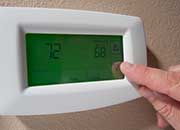- Skip Storing This Everyday Product in the Fridge Door
- Green Tea + B3 Pairing May Boost Brain Health
- Navigating Your Midlife Crisis: Embracing New Possibilities
- City Raccoons Showing Signs of Domestication
- Mapping the Exposome: Science Broadens Focus to Environmental Disease Triggers
- One Week Less on Social Media Linked to Better Mental Health
- Your Brain Changes in Stages as You Age, Study Finds
- Some Suicide Victims Show No Typical Warning Signs, Study Finds
- ByHeart Formula Faces Lawsuits After Babies Sickened With Botulism
- Switch to Vegan Diet Could Cut Your Greenhouse Gas Emissions in Half
Cooler Indoor Temps May Help ‘Good Fat’ Grow


An easy health boost may be as close as the nearest thermostat, a new study suggests.
Australian researchers found that cooler indoor temperatures stimulate the growth of healthy brown fat, while warm temperatures cause the loss of this beneficial type of fat.
Numerous studies have found that brown fat burns energy to generate body heat: it’s designed to help keep babies and small animals warm. Prior research has also shown that animals with plentiful brown fat are less likely to develop obesity or diabetes.
The new study involved five healthy men and was led by Dr Paul Lee, an endocrinologist at the Garvan Institute of Medical Research in Sydney. His team exposed the men to different room temperatures over four months: 75 degrees Fahrenheit during the first month, 66 degrees during the second month, back to 75 degrees during the third month, and 80.5 degrees during the fourth month.
The men performed normal activities during the day but returned at night to spend at least 10 hours in the temperature-controlled setting.
The 75-degree temperature used in the first and third months is “thermo-neutral,” which means the body does not have to work to produce or lose heat, the researchers explained.
The first month was used to determine the men’s starting amount of brown fat. Lee’s team found that those levels rose by 30 to 40 percent in the second (cool) month, returned to original levels in the third month, and then fell below those original levels in the fourth (warmest) month.
The effect of indoor temperatures on brown fat was independent of outdoor temperatures, the researchers noted.
The Australian group also found that the men’s insulin sensitivity increased when they had greater amounts of brown fat.
That means that that people with more brown fat required less insulin after a meal to bring their blood sugar levels down. This suggests that brown fat may be beneficial for people with diabetes, whose bodies have difficulty lowering blood sugar levels after a meal.
“The improvement in insulin sensitivity accompanying brown fat gain may open new avenues in the treatment of impaired glucose metabolism in the future,” Lee said in an institute news release.
“On the other hand, the reduction in mild cold exposure from widespread central heating in contemporary society may impair brown fat function and may be a hidden contributor to obesity and metabolic disorders,” he added.
The study was published online June 22 in the journal Diabetes and was to be presented at the joint meeting of the International Society of Endocrinology and the Endocrine Society in Chicago.
More information
The U.S. National Institutes of Health has more about brown fat.
Source: HealthDay
Copyright © 2025 HealthDay. All rights reserved.










